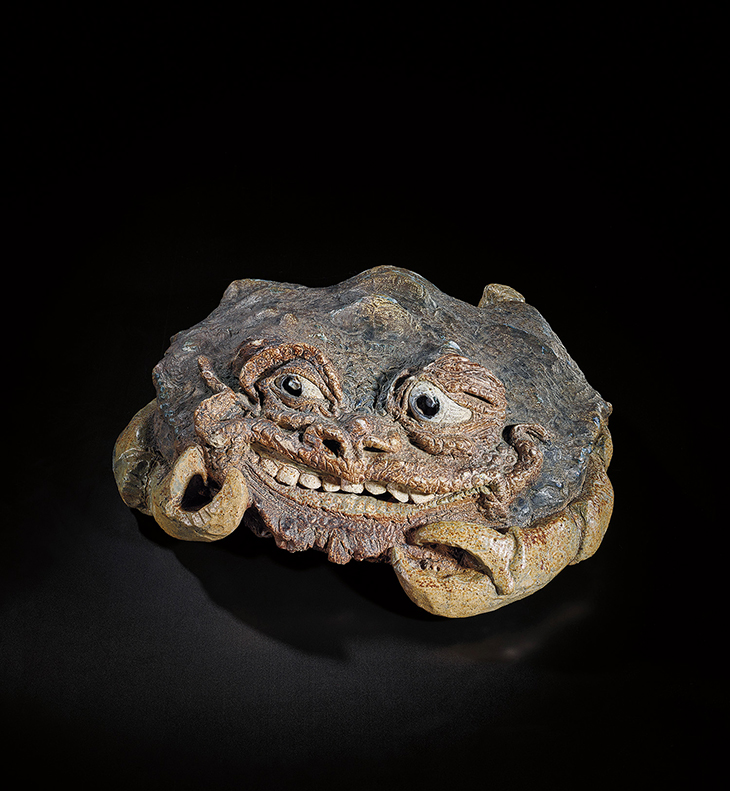Update: in February 2020, it was announced that The Box in Plymouth had acquired the crab for its permanent collection.
‘I’m normally all for the government placing export bans on art, but honestly just look at this Victorian ceramic crab. Get rid. Goodbye.’ Thus wrote Conservative MP Ed Vaizey, in response to news that the UK’s arts minister, Rebecca Pow, has placed an export bar on an important sculpture by the Martin Brothers – a grinning crab made of salt-glazed stoneware, dated 1880 – temporarily preventing it from being sold to overseas buyers. Although knee-jerk revulsion to the piece is understandable, it’s worth braving the grotesque leer and taking a longer look to understand its national significance.

An export bar has been placed on the crab, the earliest large sculpture by the Martin Brothers, until 16 September. Image courtesy of Phillips
The artists known collectively as the Martin Brothers were a band of four, led by the eldest: the imperious and eccentric Robert Wallace Martin, who had trained as a sculptor. In 1873, Robert founded their pottery in Fulham, London, beginning a creative journey that would continue evolving across a series of sites up until production ceased in the mid 1910s. The brothers straddled the Victorian world of decorative art pottery and that of 20th-century studio pottery – indeed, they are often described as England’s first studio potters.
Each brother specialised in a part of the making and selling process. Walter Fraser Martin brought technical knowledge, specialising in coloured glazes; Edwin Bruce Martin focused on throwing on the wheel and decorating; Charles Douglas Martin managed sales, albeit erratically. Together they created a wonderfully imaginative body of work ranging from gothic-inspired pieces modelled by Robert, which are alternately comic and sinister, through to Edwin’s refined vessels that show the influence of both japonisme and art nouveau.
This early anthropomorphic crab belongs to the worlds of Edward Lear and Lewis Carroll: that quintessentially English surrealism of Cheshire Cats, Jabberwockies and Snarks that reflected Victorian mores through a looking-glass lens. It belongs, too, to Britain’s long tradition of satire. The Martins’ famous ‘Wally’ birds – sculptural jars for storing pipe tobacco – often lampooned prominent figures through mischievous avian likenesses; the best-known examples caricature prime ministers Benjamin Disraeli and William Gladstone. ‘When you enter the shop,’ wrote the journalist Holbrook Jackson in 1910, following a visit to the brothers, ‘you find yourself in a dim-lit passage with crowded shelves of stoneware jugs carved into leering, laughing, grinning and ogling heads jostling with the most impossible, and most fascinating, pot birds with strangely anthropological expressions.’
Much like the brothers’ output as a whole, the expression on the crab’s humanoid face is difficult to categorise. The catalogue for Phillips New York’s auction in December 2018, which saw the sculpture achieve a record hammer price of $275,000, described it as ‘faux jollity mingled with embarrassment and even terror’. Is it too far-fetched to interpret the monumental crab as reflecting Victorian anxieties regarding the relationship between the animal and human worlds, as a new scientific age gained momentum? It seems plausible – particularly given the fervent religiosity of the elder Martin, a member of Christian group The Plymouth Brethren.
As pioneers working at the very beginning of the studio-pottery movement, the Martin Brothers battled technical challenges. Over-sized pieces such as this crab, which measures nearly half a metre across, were particularly difficult. While other potters used saggars – barriers that protect work from the kiln’s flames – they did not. A cripplingly high percentage of Martinware emerged either under- or over-fired, either unsatisfyingly pale or blurred and burnt. They fired each piece only once, which likewise increased the chance of failure; sometimes only one piece of good quality would emerge from a firing. Unsurprisingly, their greatest challenge was economic, a situation worsened by their lack of commercial nous. Charles hated to part with their wares, going so far as to hide the finest pieces away from the eyes of customers. In moments of extreme financial pressure, they were reportedly reduced to burning their own furniture to keep the kiln firing and production going.
The Martin Brothers’ remarkably rich oeuvre, and particularly monumental pieces such as this crab, were created against the odds and mark a high point of Victorian pottery. Yet unless a UK buyer matches the asking price of £217,250 (plus VAT of £43,450) by 16 September (or by 16 December if a ‘serious intention to raise funds’ is underway), the characterful crustacean will be lost abroad. Sir Hayden Phillips, chairman of the Department for Culture, Media and Sport’s advisory body, commented: ‘A truly grotesque creature, it represents the pinnacle of their work, and we also concluded that it was of outstanding aesthetic importance reflecting the fact that this criterion does not necessarily imply that an object has to be beautiful to pass that test.’ He added: ‘This crab is of a quality and scale lacking in UK public collections and I hope one of them will come forward to give it a good home so it does not disappear again.’ It may not be to everyone’s taste, but when viewed in context, this is a crab worth clawing back for the nation.















![Masterpiece [Re]discovery 2022. Photo: Ben Fisher Photography, courtesy of Masterpiece London](http://zephr.apollo-magazine.com/wp-content/uploads/2022/07/MPL2022_4263.jpg)
‘Like landscape, his objects seem to breathe’: Gordon Baldwin (1932–2025)